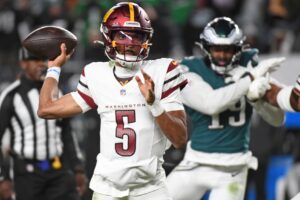With the 2021 NFL Draft quickly approaching, the topic of the best possible way to draft has been heavily debated once again. Should a team prioritize drafting value or need? Some teams, such as the Miami Dolphins and Jacksonville Jaguars, have a high amount of draft capital with many team needs. So how can these teams optimize their draft capital to be the most valuable? Let’s take a look…
Why NFL Teams Should be Drafting Value Over Need
Value of Rookie Contracts
First things first, rookie contracts are extremely cheap compared to second contracts and beyond. The last four number one overall picks (Joe Burrow, Bengals; Kyler Murray, Cardinals; Baker Mayfield, Browns; and Myles Garrett, Browns), all averaged approximately $8.4 Million per year on their rookie contracts. For context, the highest-paid quarterback in the NFL, Patrick Mahomes, averages about $45 million per year on his second contract. Without question, the best financial situation for a competing team is to have a quarterback providing elite play while on their rookie contract. After all, it gives them flexibility to build around that player and create the best roster possible.
Taking this into consideration, the same concept can be applied to other positions. At other expensive positions such as offensive tackle, edge rusher, or wide receiver, using draft picks with cheap deals proves to be extremely valuable. For a perfect example, look no further than the Tampa Bay Buccaneers‘ 2020 first-round pick, offensive tackle Tristan Wirfs. Wirfs’s cap hit on his rookie season, as the 12th overall pick, was a little under $3 million. For an offensive tackle providing elite play as Wirfs did, the Buccaneers are getting away with highway robbery given his contract. Ultimately, if a team were able to get such exceptional performance at an expensive performance while that player is on a rookie deal is very beneficial.
What Does This Mean for Teams in the Draft?
It has been established that getting quality play at expensive positions on cheap rookie deals is practical for any team. What this leads to is rather than drafting to fill holes, teams should target talented players at these expensive positions. Logically, this means avoiding running backs early in the draft. The average annual salary of a running back lurks around $300,000 annually. A perfect example of a first-round running back pick that was less than ideal was the Kansas City Chiefs‘ selection of Clyde Edwards-Helaire with the 32nd overall pick in the 2020 NFL Draft. Now, there is no doubt that Edwards-Helaire is a quality player at the position. However, his cap hit in 2020 was $1.9 million. Rather than spend that money on a running back, one of the cheapest positions, why not select a more valuable position like offensive tackle or a rotational defensive lineman, even?
It is also easy to piece together a case against drafting a running back in the first round. Simply put, James Robinson, an undrafted free agent for the Jaguars, ended up outplaying Edwards-Helaire in 2020. All while Edwards-Helaire’s deal earned him significantly more than Robinson. The Chiefs used early draft capital on a low-value position, and it has come back to haunt them. Their selection of a low-value position last year now leaves them in need of several other important positions, which could end up being a real issue for them in 2021.
Last Word
At the end of the day, NFL teams should be drafting value over need. Signing a veteran wide receiver on a one-year deal should not stop a team from drafting a player at that position. Teams are built through the draft. So select players who will impact your team with a low cap hit relative to other players at their position.
Main Photo: Embed from Getty Images






